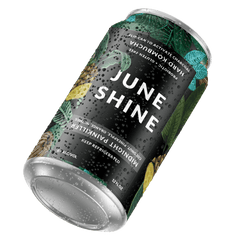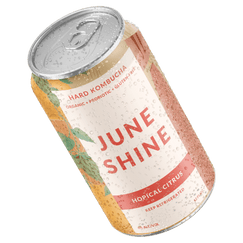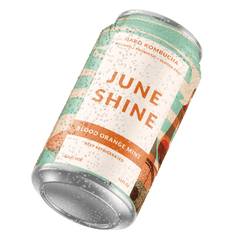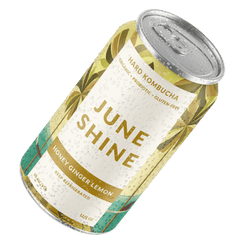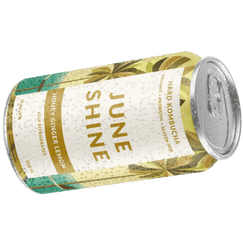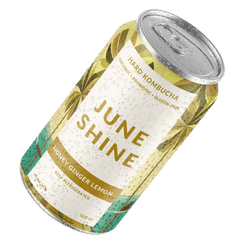What Does Green Tea Taste Like? Here Are a Few Examples

What Does Green Tea Taste Like? Here Are a Few Examples
The world of teas is like a perpetual rainbow; black teas, white teas, green teas, purple teas (yes, purple). For those looking to start sipping tea for the first time, where do you start?
Let’s dive in (not literally—that would be way too hot). Green tea is one of the most popular types of tea in the world, and for good reason!
What Is Green Tea?
Green tea is well-known for its health benefits, including supporting healthy cholesterol and fat levels, treating high blood pressure, and lowering the risk of certain cancers and heart disease. But that’s not the only reason that we’re drinking it.
This tea is also renowned for its distinct taste and it’s flavoring is found in coffees, milk, pastries, and now, even kombucha! This tea is bittersweet, earthy, and sometimes even grassy, which we promise is a good thing. Of course, the exact flavor profile will depend on what kind of tea it is.
Not all green teas are the same. The difference between sencha, matcha, and blended teas is legit.
For green teas, producers tend to use younger leaves from the Camellia sinensis plant. Before being dried, these leaves and leaf buds are steamed and pan-fried.
This drink provides a balanced but complex profile that’ll help you understand the makeup of other teas. Before long, you’ll be a tea maniac, guzzling oolong, black tea, and kombucha (of course) like nobody’s business.
Savory Sencha
Ready to go green? Sencha is a Japanese loose-leaf green tea that was first brought to Japan in the 17th century from China. Once this tea hit Japan, it became a worldwide commodity. In fact, 80% of all tea that comes from Japan is sencha.
A huge appeal of making sencha is that it doesn’t require any preparation in advance, unlike some other teas. That means drinking it is as easy as heating water, steeping, and enjoying.
In terms of taste, sencha is simple and chill. Typically, it doesn’t contain any additional flavorings. Sencha’s flavor profile is fresh and herbal. Depending on how long it was steeped, you may also notice hints of Brussels sprouts, kiwi, and spinach.
For first-timers, the taste of sencha may catch you off guard with its bitterness. However, as you continue to sip it, you’ll begin to notice its more sweet and savory properties. Sencha may take some getting used to, but before long, you’ll be a lean, green, tea-drinking machine.
Sencha is as traditional as it gets when it comes to green tea. Simply put, this is the way that green tea was made to be drunk. It’s like you’re taking sips of history.
Matcha Madness
If you’ve ever been to an Asian bakery or tea shop, you’ve almost certainly heard of matcha. You’ll find it as straight tea, sure, but also in matcha brownies, cupcakes, breads, and so much more.
Just take a stroll down Koreatown in Los Angeles. If you had a nickel for every sign that’s advertising matcha, you’d be able to buy unlimited JuneShine for life.
Okay, maybe not quite. But its prevalence is no joke. Before sencha was brought over to Japan, matcha was the go-to tea for people in the country. Now, it is gradually becoming the go-to tea for people around the world.
If you’ve been living under a rock the past few years, don’t worry. Here’s a quick breakdown of this beloved Japanese tea: matcha is a green tea powder produced from finely grounded, dried tea leaves. It is commonly used in milkshakes, lattes, frappuccinos, and bubble teas among other things.
This tea is also a powerful antioxidant, even more so than regular green tea. When other types of green tea are made, the leaves are usually steeped in hot water, then thrown away. With matcha, though, the powder from the leaves is whisked in hot water or milk, allowing the entire tea leaf to be used. Therefore, more of its antioxidants are present.
It also contains more caffeine than your average green tea. However, matcha doesn’t really give you a jolt of energy like coffee or energy drinks do. Instead, it provides a gentle boost of energy and focus, while keeping you calm, all without the jitters that so often come from coffee. It’s all about that easy, enjoyable energy.
You might notice that this tea is greener than other green teas. Well, it tastes exactly how it looks. When you take a sip of matcha green tea, you’ll first be hit with a wave of bright, vegetal flavors. This Japanese tea is made from leaves with high chlorophyll levels, which gives it its vibrant, green color and that super earthy, dense flavor.
Mixed or Blended Teas
Looking for a little more oomph? Try mixed or blended green teas, which toss in additional fruits or flowers for flavor.
This is the most popular green tea you’ll find on the shelf of your local supermarket or grocery store. Pure green teas are rarer to find, as most people enjoy green tea with extra sweeteners or flavorings. Can you blame them? These teas are goooood.
Most green teas with highly floral or fruity profiles are blended. First-timers may enjoy the taste of blended green tea better than pure, so it’s a fab first step to joining the ranks of tea-lovers everywhere.
Blended green tea mixes are also used routinely in many foods and drinks. Ever enjoyed our Grapefruit Paloma? It may not have tea in its title, but check that all-natural ingredients list. This sweet, fruity drink is complemented beautifully by its accents of fresh green tea, with a little extra fun mixed in.
Go Green (Tea)
Simply put, green tea is a game changer, but it can take some getting used to. If you’re struggling to find a version you love, take your time. Like wine and coffee, it can take a little bit of drinking experience to accurately describe what flavors you’re tasting in a tea.
And if you’re looking to dip your toes in the proverbial ocean of tea, that’s what we’re here for. Our hard booch incorporates green tea, along with a delicious blend of green tea, honey, juice, and spices for a flavor that you won’t be able to get enough of.
Sources:
The Guide to Koreatown in Los Angeles | Discover Los Angeles
Health Benefits of Matcha Tea | Time
